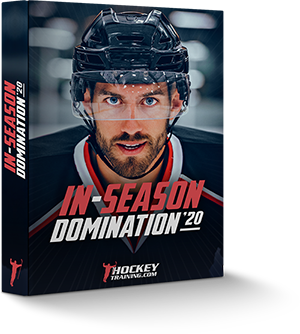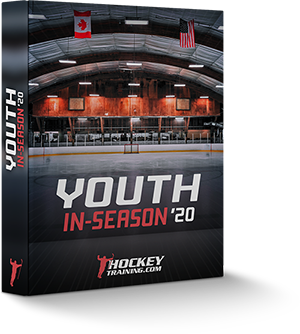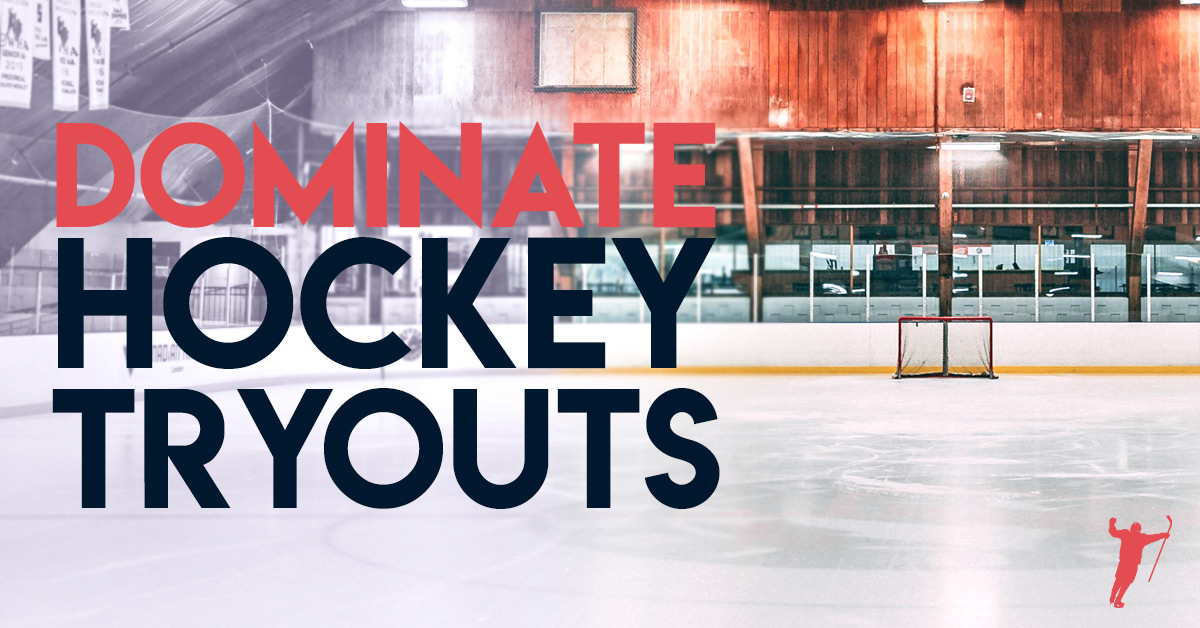In this article, I’m going to unpack the four biggest reasons why NHL players train throughout the in-season—and why you should too!
It has always baffled me how so many hockey players dream about making it to the next level and becoming the best hockey player they can be—yet at the same time, they discontinue all training during the in-season.
This is wrong on so many levels. The average season is roughly six months in length, so if you take the in-season off from training, you’re literally shaving off 50% of your training time per year.
Who do you think is going to be the better hockey player out on the ice: the one that trains and makes progress year-round, or the one who trains for half the year but then decides to skip all of his/her training until they become bored enough with their time off the following off-season to start it up again?
Obviously, the more dedicated hockey player is going to perform better. This becomes especially true as the years add up and the gap between them gradually gets larger.
If you think taking the in-season off from training is the right thing to do for your performance, consider this: why does every NHL team have a full-time, well-paid strength and conditioning coach train the team all in-season long?
Do you think every single NHL organization is simultaneously making a giant mistake? Or do you think that the best athletes and coaches know what they’re doing to stay in top physical condition on a year-round basis?
My guess is the latter, and yours should be too. The moment you decide to take control of your in-season training is the moment you will unlock your potential in this game.
I don’t want you to suffer the fate of an unproductive season. I want you to be the best player you can possibly be, and during the in-season, this means adapting your schedule to make sure you stay strong and explosive all in-season long.
With that said, let’s have a look at the top four reasons why no NHL player thinks it’s a good idea to take the in-season off from their dryland training.
#1: Fitness Characteristic Decay Rates
When setting up your programming, it’s vital to keep in mind “fitness characteristic decay rates.” This refers to the minimum effective dose of training volume/intensity that is required to maintain what you gained during the off-season:
- How much do I have to lift to maintain my size during the season?
- How heavy should I go if I want to maintain my strength during the season?
- How should I maintain my explosive speed?
Luckily, with advancements in sports science knowledge, we can answer these questions quite confidently (for more in-depth information, refer to: 1, 2, 3, 4, 5, 6).
Here’s how it breaks down in a nutshell:
Hypertrophy: Muscle size can be conserved indefinitely with only strength training and zero hypertrophy work—that is, training with loads greater than 80% of your 1-Rep-Maximum.
Strength: Strength can also be held indefinitely with only strength training and zero hypertrophy work—that is, training with loads greater than 80% of your 1-Rep-Maximum.
Speed: Speed levels without speed training exposure will begin to decline after only two weeks.
Power: Power output rates without power training exposure will also begin to decline after only two weeks.
This means that if we incorporate loads with 80%+ of our 1-Rep-Maximum throughout the season, we can maintain both our strength and our size. This is incredible knowledge to apply immediately, because these play a huge factor towards stride length, strength on the puck, shot power, and injury prevention.
But we also know that without frequent exposure to speed and power work, you can begin to lose those particular physical qualities within two weeks. These two qualities are the most “sensitive” to physical decay rates, and unless we program properly for that you can begin to slow down even within the first month of the in-season.
Have you ever intuitively noticed that as a hockey player yourself? You train your butt off all summer and come into tryouts or camps like a blazing fire. Then, perhaps only a couple of months later, you just don’t feel like you’re at the same level of speed or strength.
You might think that this is just “feeling the grind” of the in-season, and although that’s partly true, the more accurate reason is that these are physical characteristic decay rates being played out in real life.
What’s funny to me is that many hockey players avoid training altogether during the season because they feel the grind too much—but the grind actually represents an athlete that isn’t training enough! The grind is simply a decrease in performance due to poor in-season training program design (more on this below).
Now, as a disclaimer about two things you probably already know because I beat them to death in everything I write but have to say here as well: physical decay rates don’t mean a thing unless you are eating and recovering properly.
Always remember: You aren’t what you can do. You only are what you can effectively recover from.
If your recovery from games, practices, and training is sub-optimal, then all of your characteristics can begin to decay regardless of your training strategy.
Recovery and diet are the foundation for which all things hockey performance rely on. A fatigue debt is a fatigue debt no matter which way you spin it—and debts of fatigue gone unpaid will result in overtraining and eventual burnout. Similarly, if you aren’t eating a diet specifically for hockey athletes, then all of your characteristics can begin to decay as well (again, regardless of training strategy).
Emphasizing recovery means that you are prioritizing hockey performance, because you will be entering each game and practice as your best self rather than an overtrained version of you.
Knowing this, if all is where it should be regarding nutrition and recovery (which it should be if you’re serious about hockey), these research-based decay rates that I listed above are incredibly accurate.
NHL players and coaches know this, and that’s why the players’ diets are dialed-in and why they run in-season specific programs all in-season long—because if they don’t, they will become smaller, weaker, and slower than the other teams who are continuing to train.
#2: “The Grind” Isn’t What You Think It Is
I stated above that “the grind” most hockey players talk about is completely misunderstood.
Most hockey players think that they are feeling worn down from too much work during the in-season, but they don’t realize that the only reason they feel worn down is because their bodies are becoming detrained.
Once you understand the fitness characteristic decay rates, it becomes pretty simple to conceptualize that these athletes aren’t worn down; instead, they are suffering the predictable outcome of not training.
The old saying holds true here: If you don’t use it, you’ll lose it!
Don’t blame a lack in size, strength, and explosiveness on being worn down—the only reason you’re declining in these areas is because your in-season program wasn’t designed properly in order to provide the right volumes and intensities for you to stay strong and fast all season long with no worries of decay.
“But Coach Garner, isn’t practice enough?” Unfortunately, no.
It’s obvious why practice isn’t enough for strength and hypertrophy since you aren’t lifting weights, and losing these two qualities alone is devastating to hockey performance. But even beyond this, practice alone isn’t even good enough to maintain your speed and conditioning levels.
Not convinced? Let’s look at some well-controlled research from Team USA on the differences in cardiovascular demand between a practice and a game.
To summarize, it was found that the mean working heart rate during practice was 76%, whereas during a game it was 90%. This is a 14% deficit during practice, which just simply doesn’t cut it. If you look at this from a school-grade perspective, it would be like saying that you could get an A in class with only a C-level effort.
Furthermore, the researchers also found that the mean time spent working at over 90% of your maximum heart rate in a game was 10.5%, whereas during a practice it was only 5.6%. The game demands you spend nearly twice as much time at that level of output! So how on earth could a practice prepare you for that?
The simple answer is that it can’t.
The grind isn’t what you think it is and practices aren’t enough to maintain your fitness levels. It’s time to make sure that you’re working at known intensities all in-season long that have predictable outcomes on your performance.
#3: Maximum Injury Prevention
When you resistance train throughout the season, you add more body armor to your frame in the form of sport-specific muscle tissue.
In physics terms, this means that the larger a surface area is, the better its ability to dissipate impact forces. In hockey terms, this means bigger muscles better dissipate impact forces and vibrations (caused by events such as falling, getting body checked, giving a body check, or staying strong in front of the net), so that no single area bears the brunt of concentrated force.
Furthermore, resistance training not only strengthens your muscles—it also strengthens your tendons, ligaments, bones, and connective tissue as well.
For all of these reasons, hockey players should have a year-round periodization strategy that includes resistance training so they can maximize both the performance benefits and the injury prevention benefits.
It just doesn’t make sense to discontinue the primary force keeping you injury-free during the time of year where you’re most likely to get injured. Consistent resistance training will keep you from needing to do injury rehab movements.
#4: All-Around Optimal Performance
It’s important to point out that just because you’re training doesn’t mean you will be too fatigued for your games and practices.
Performance is always number one during the season. We do not train with the same type of intensity, frequency, and volume as in the off-season. Leave the grueling workouts and programs for the off-season.
The off-season is truly where advances are made in physical development. A good off-season can simultaneously improve a hockey player’s size, strength, and speed.
If players slack off in the off-season, they can’t expect to get better over time, because it is in the off-season where the best physical progress is made due to having the schedule flexibility and fatigue management to be able to handle five to seven training sessions per week.
Think about the off-season and the in-season like progression vs. expression: the off-season is the best time of the year to make the largest and greatest physical development progress, and then during the in-season, you can express this newfound ability and skill.
Proper in-season hockey training will not empty your gas tank; instead, it will allow you to hold on to what you gained during the off-season (and in lots of cases, make even further progress due to the new style of training combined with your ice work).
A good in-season schedule should check all of the boxes for hockey performance so that you enter each game and practice an absolute beast out on the ice.
Here’s how I have the elite hockey players here at HockeyTraining.com scheduling their sessions this year:
Day 1 – Lower Body
Day 2 – Upper Body
Day 3 – Core Training and Edge Work Optimizer
Day 4 – Neural Performance Protocol
Day 5 – Total Body Mobility
Day 6 – Hockey Yoga
Day 7 – Off
When you have a schedule like this, where your in-season training follows the exact volumes and intensities necessary to offset decay rates from every angle, you will astound parents and coaches with how much progress you have made in such a short time frame.
Ready To Dominate This Hockey Season?
If you’re serious about becoming a better hockey player this year and you want to take your abilities to the next level, then pay very close attention here, because starting today, you can be one step closer to making your hockey dream a reality with our new 2020 In-Season Training System that features the all-new OPT6 Peak Performance System™.
The OPT6 Peak Performance System is backed by the latest knowledge in sports performance and aims to provide you with the necessary amount of training stimulus needed to improve upon your strength and explosiveness without overtaxing the nervous system during the hockey season.
You don’t have to be a “natural talent” to instantly up your game and have the best season of your life this year—because you can get instant access to the exact on-ice and off-ice training you need to be doing this year during the in-season, so you can train just like your favorite NHL player.
Sure, you could go through all the research studies I have read and slowly piece everything together and you’d probably do just fine…but, if you want to take all of the guesswork out of it and get access to a completely “done for you” high-level program to get the best possible results, then head on over to our In-Season Training System page and let’s get started today.
Lean on my experience of working with thousands of hockey players (including NHL players) and discover what you need to do in order to be your absolute best on the ice.
Unstoppable speed, edge work, conditioning, and agility are all a reality for you this year; join the team here and let’s crush this thing.
Final Thoughts
It was my intention with this article to unpack the top four reasons why all NHL players train throughout the in-season and why it is mandatory to do so for the best possible results.
Here’s a quick recap of those reasons:
- Fitness Characteristic Decay Rates
- The Myth Behind “The Grind”
- Maximum Injury Prevention
- All-Around Optimal Performance
If you would like to learn more about these principles and watch a professional presentation I have put together for you, then click “play” below and don’t forget your notepad! This one is packed with great information.











